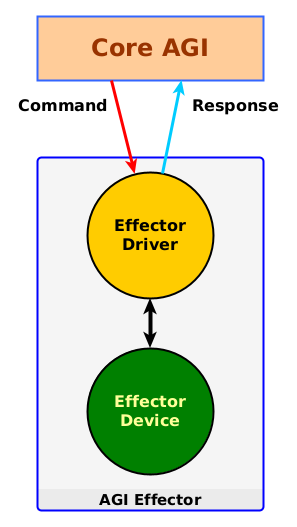AGI architecture includes effectors, which are understood as sensors and actuators.
Effectors are a kind of ambivalent element, being controlled by the AGI system and at the same time being part of the natural or virtual embodiment.
Both sensors and actuators imply "smart" devices/units that carry a two-way exchange of information with the AGI system itself. AGI sends commands to the effector and receives data in response. From the AGI point of view, the difference between sensors and actuators is that the purpose of sensors is to collect information about the current situation, and actuators are to change the situation. In the natural environment, it is not uncommon when the information acquiring inevitably affects the tested environment; therefore, the combination of sensors and actuators into one concept of effectors is entirely justified.
Sensors generally imply the use of an active sensing approach, when the information received depends not only on the environment, but also on what/how it is requested - for example, on where the video camera is directed, how the tactile sensor moves, how the radar/lidar is oriented, and so on.
Actual "smart" sensors and actuators use the associated communication protocol, different for different effectors. This requires the use of drivers that converts the specific effector protocols with the internal AGI protocol of the information exchange system. The standard internal communication protocol allows interpreting the exchange of information with effectors using the HMI component, maintaining the interpretability of processes in the AGI system.
At the logical level, a driver is implied as a component of the effector:
In addition to the main functions, the effector usually also performs specific service operations: initialization upon connection, self-testing, calibration, zero setting, and so on.
Communication between the core of the AGI system and the effectors is assumed to be asynchronous; sending a command to an effector generally does not require waiting for an immediate response.
An essential aspect is that the set of effectors is entirely determined by the purpose/mission of the system controlled by the AGI. Generality in "AGI" concerning effectors means the possibility of using a common AGI implementation, using a common data exchange protocol, and preloading information about effectors into Semantic Storage and Data Storage as “congenital” knowledge. This preloaded information determines how the description of the current situation is constructed and what sets of elementary actions can be used. The actual complexity of such actions can be arbitrarily high - up to using another instance of the AGI system as an effector.



